The WHT is an alt-azimuth mounted telescope and has four focal stations. A corrected prime focus beam of f/2.8 or an f/11 beam where the light path can be directed to either of the two Nasmyth platform enclosures via the Nasmyth mirror or directly down to the Cassegrain focus.
It weighs 190 tonnes and floats on oil forced under high pressure into the azimuth bearing. Large telescopes using alt-azimuth mountings only became viable when computer control was introduced as not only do both azimuth and altitude axes need to be driven at different speeds to achieve a sidereal tracking rate, but a third motion (image derotation) needs to be applied also. If this is not done, trails will be seen on the image recording medium (CCD, film plate, etc) due to field rotation in that the mounting is not aligned to the pole. To overcome this, the WHT uses two image derotation systems. The Cassegrain and prime focus turntables move at the correct rate to remove this effect thus the instruments themselves are slowing rotating with time. In the case of bulky fixed instruments on the Nasmyth platforms, derotation optics mounted on a small turntable present a corrected beam to the instrument/detector.
The WHT is still currently the largest telescope at the ORM, but will soon take second place once the 10.4 metre GranTecan is commissioned. When the WHT came into operation in 1987, it was ranked the third largest telescope in the world after the 6 metre Russian telescope and the 200 inch (5 metre) Hale telescope at Mt Palomar, California.
On a historical note, it was also the last telescope that the Newcastle firm of NEI Grubb Parsons would build. This company with its roots in the 19th century had supplied many observatories around the world with their instruments and its association with the RGO had lasted for almost 100 years.
During the commissioning phase in 1987, I had the rare opportunity to visually observe using this telescope! We fitted an eyepiece on to a frame at one of the Nasmyth foci and seated on a chair (like as in the James Nasmyth engraving) we directed someone in the control room via radio to move the telescope to various objects. For me without doubt, viewing Saturn through a 4.2 metre telescope was an experience I'll never forget. The detail was incredible like seeing a plaited structure within the rings and small moons lying very close to the ring plane. Remarkable...
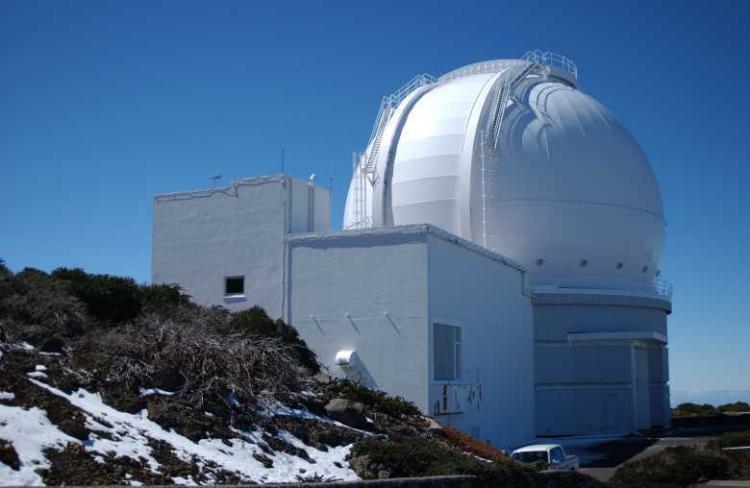
THE WHT BUILDING
The building consists of two sections. The drum with the dome and the annex. This arrangement ensures that no heat from staff working areas can rise up into the dome. When the dome is open, large fans around the base of the drum ensure a continuous flow of air circulates through the building and across the telescope to minimise turbulence which can effect image quality. The annex houses the control room, staff offices and labs, but most of the area is occupied by the mirror aluminising plant.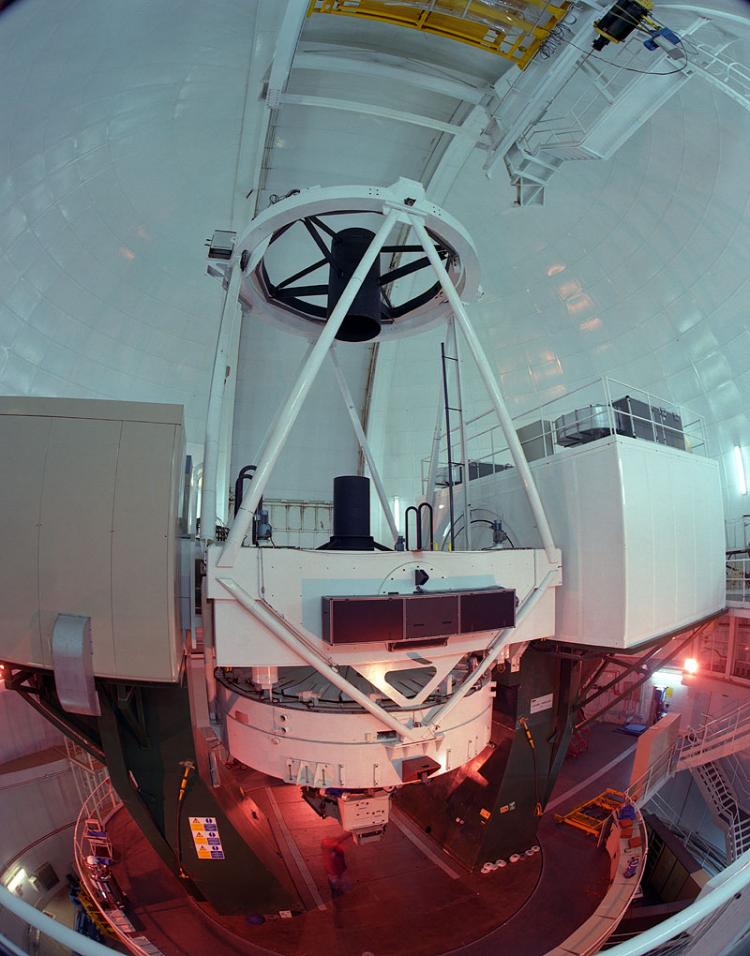
The 4.2 metre WILLIAM HERSCHEL TELESCOPE (Credit: Jens Moser December 2003)
An excellent image of the telescope found in the ING archives. Only when seeing a 'fish eye lens' view like this can one appreciate the size of this telescope. Considering how heavy it is, the pointing accuracy over the entire sky is in the order of ~1.4 arc-seconds. Such a high accuracy is achieved using precision cut spur gears and high quality encoders and servo motors.The Nasmyth platform enclosure to the left: GHRIL (Ground based High Resolution Imaging Laboratory) contains WYFFOS which is used in conjunction with AF2, the WHT's prime focus multi-object fibre spectrograph. There is also an optical bench installed for specialised instrument setups. The enclosure to the right: GRACE (GRound based Adaptive optics Controlled Environment) contains NAOMI, the WHT's adaptive optics system. The telescope will soon be fitted with a laser to produce an artificial guide star which will enhance the adaptive optics system even greater.
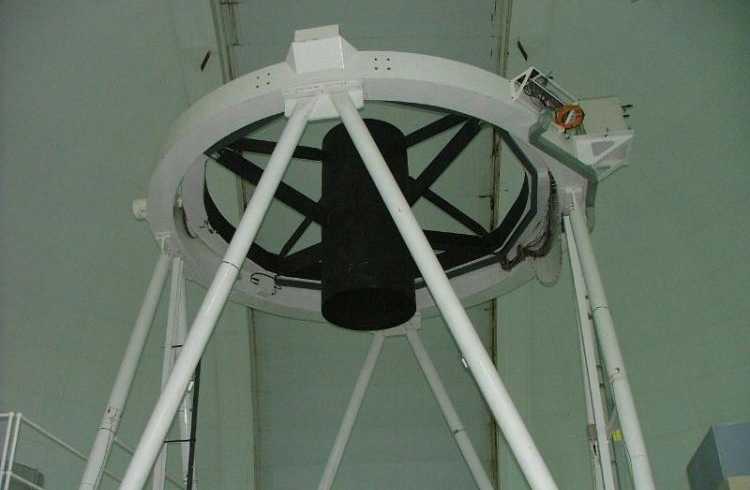
Showing the Flip Ring
The inner ring can be rotated through 180o to gain access for removing the secondary mirror when changing to observe at prime focus. This operation is performed when the telescope is parked at the zenith. It takes a few minutes to flip the ring as locking bars need to be released then re-applied before and after the move. The telescope is then brought down to the final access park position, clamped to the dome walkway and the secondary mirror cell removed from the tube. A change to prime focus takes about 3 hours.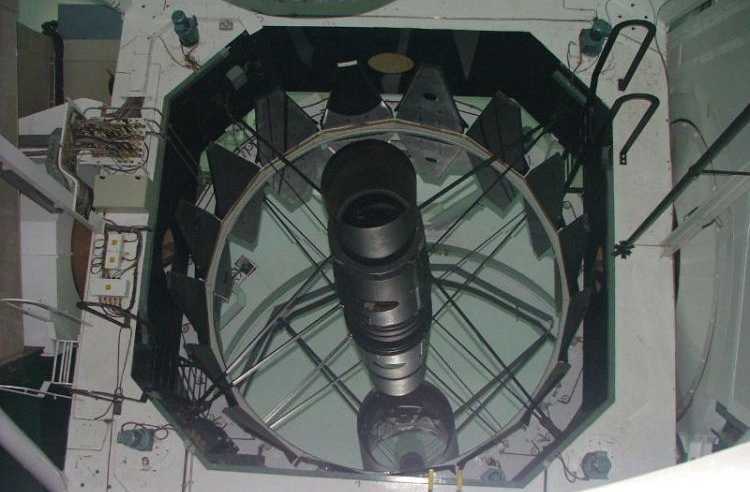
The telescope near access park with the primary mirror cover petals opened
This image shows the Nasmyth mirror turret. The mirror can be swung out to 45o and rotated to direct the f/11 beam to one of the Nasmyth focal stations. When the mirror is stowed (i.e. vertical), the beam passes to the Cassegrain focus. Push buttons on the engineering desk in the control room select the focal station. It takes 4 minutes to switch between the Cassegrain and a Nasmyth foci. The four (blue) motors at the each corner of the massive box section drive internal weights up or down to fine balance the telescope.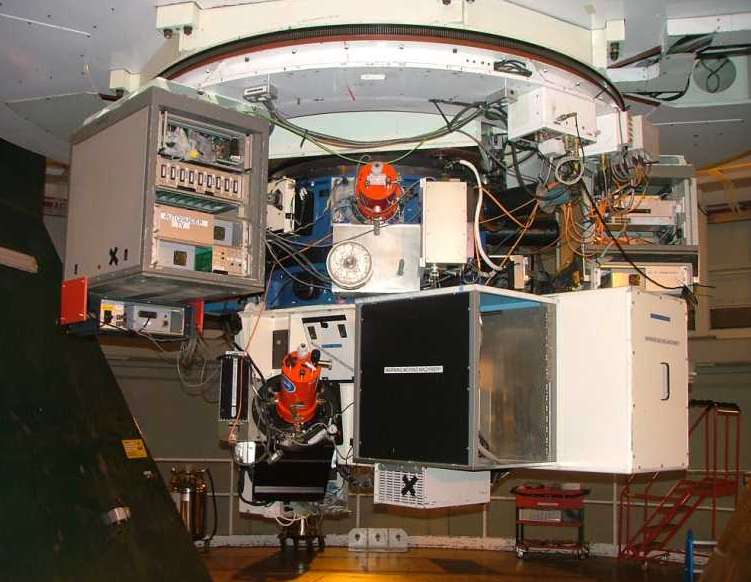
Cassegrain Instrumentation
This shows the most common configuration with ISIS (the double beam medium dispersion spectrograph) fitted. This instrument is unique in that it can take spectra both in red and blue wavelengths simultaneously using dichroic filters. The cooled CCD cameras are housed in the red cryostats. The camera at the top is mounted on the acquisition and guiding unit and is used for direct imaging. A mirror can be positioned into the beam which diverts light into this camera. The lower camera is the detector for the 'red arm' of ISIS.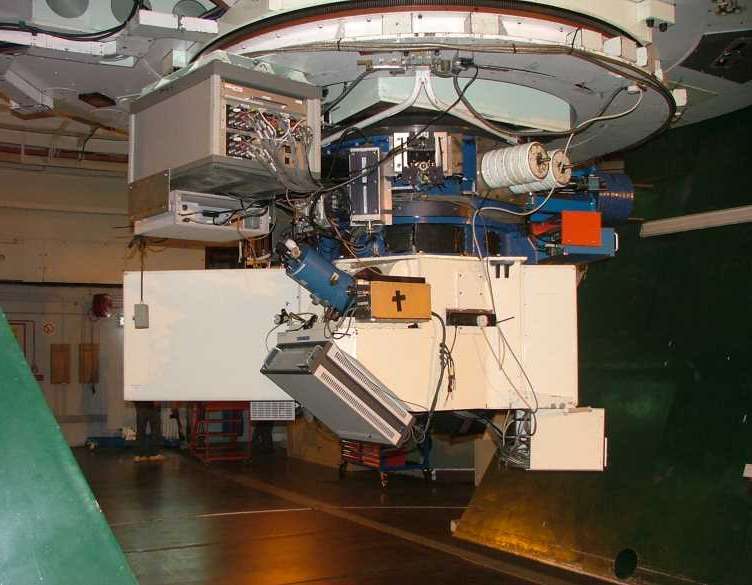
A view from the other side of the spectrograph showing the 'blue arm' CCD detector of ISIS.
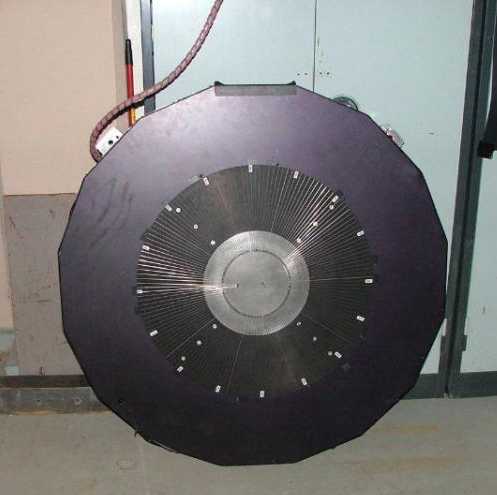
The AutoFib 2 fibre module
AF2 works in conjunction WYFFOS (Wide Field Fibre Optic Spectrograph). It is a multi-object, wide-field, fibre spectrograph working at prime focus.Shown in the photo is the fibre module which looks towards the mirror when mounted. There are 150 science fibres each of 1.6 arc-second diameter. The field of view covered by the fibres is 1 degree diameter. There are also additional fibres used for acquisition and guiding.
At the end of each fibre (the module end) is cemented a small prism on a magnetic button. The fibre run from prime focus to WYFFOS (housed in GHRIL) is 26 metres. The run is continuous with no in-line connectors which can attenuate the light throughput.
The fibres are positioned using a precision X-Y motion robot with a 'gripper' mechanism. Computer generated co-ordinates of the targets are sent to the robot which picks up each in fibre in sequence and places it (one hopes!) in the correct position on the back plate. Its fascinating watching this process taking place on a TV monitor in the control room.
A typical use for a multi-fibre spectrograph would be in the study of clusters of galaxies where spectra can be obtained from many objects within the field simultaneously.
More information on AF2 can be found here.

Showing part of NAOMI on the optical bench within the GRACE enclosure
NAOMI (Nasmyth Adaptive Optics for Multi-purpose Instrumentation) is a fairly recent addition to the suite of WHT instrumentation. Its purpose is to remove the effects of atmospheric turbulence (in real time) and present a near diffraction limited image to the detector. The image quality after AO processing is remarkable and fine detail that would normally be lost due to turbulence is clearly visible. A key component of NAOMI (and the most expensive!) is the segmented 76 element 'Deformable Mirror' which can respond very rapidly and cancel out distortions due to turbulence. Click here for a detailed description of NAOMI.Click here to have a look around the WHT control room and aluminising plant. (Coming soon)

